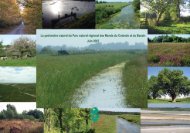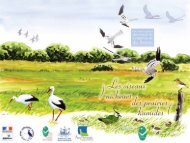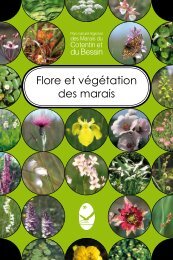Where to watch our wildlife ? - Parc Naturel Régional des Marais du ...
Where to watch our wildlife ? - Parc Naturel Régional des Marais du ...
Where to watch our wildlife ? - Parc Naturel Régional des Marais du ...
Create successful ePaper yourself
Turn your PDF publications into a flip-book with our unique Google optimized e-Paper software.
Le Lieu<br />
<strong>du</strong> Cheval<br />
Le Lieu Gilles<br />
Le Château<br />
vers<br />
Vouilly<br />
16<br />
13<br />
ruisseau <strong>du</strong> Coudray<br />
Saint-Jores<br />
Le Manoir<br />
Béatrix<br />
marais suhard<br />
ruisseau <strong>du</strong> Moulin d'Annebey<br />
Le Bouillon<br />
L'isle<br />
The Colombières<br />
countryside<br />
Lieu<br />
Folleville<br />
49.29699, -0.98032 10,5 km - 3h<br />
The walk through the Colombières countryside allows the visi<strong>to</strong>r <strong>to</strong> discover<br />
another part of the Aure marshes and especially the hedgerow<br />
countryside of higher land.<br />
The marshes are a transition zone between the limes<strong>to</strong>ne and marls of<br />
the Parisian bassin <strong>to</strong> the north and the schists and sands<strong>to</strong>nes of the<br />
Armoricain massif <strong>to</strong> the south. The countryside here is dominated by oaks<br />
and sweet chestnuts, whereas <strong>to</strong> the north the disappearance of Elms has<br />
given way <strong>to</strong> Ash and Field maple. Meadows, crops, hedgerows, ponds<br />
and orchards allow the visi<strong>to</strong>r <strong>to</strong> see <strong>wildlife</strong> typical of the countryside of<br />
western France.<br />
Ferme de la<br />
Suharderie<br />
Le Perrey<br />
ruisseau de Corainville<br />
Le Buisson<br />
La Lande<br />
La Campagne<br />
Hameau Minet<br />
La Maresquerie<br />
D5<br />
Le Lieu<br />
Vaudel<br />
La Perelle<br />
Corainville<br />
Thionville<br />
Le Couvent<br />
Ferme de<br />
la Ronde<br />
!<br />
La Perruque<br />
Château de<br />
Colombières<br />
Le<br />
Feuillet<br />
Colombières<br />
Ferme <strong>des</strong><br />
Hutereaux<br />
La Houssaye<br />
l'esque<br />
La Poterie<br />
La Basse<br />
Rivière<br />
La Campagne<br />
La Malvoye<br />
vers<br />
Le Molay-<br />
Littry<br />
Look for<br />
Hedgerow flora ( 1 Early purple<br />
orchid, Lesser celandine,<br />
4 Harts<strong>to</strong>ngue, Male fern), ancient<br />
oaks.<br />
Breeding hedgerow passerines<br />
(warblers, thrushes, Redstart,<br />
tits…).<br />
Breeding marshland birds, hunting<br />
Hobby, and Little and Cattle<br />
egrets.<br />
Wintering hedgerow birds<br />
( 2 Fieldfare, finches…).<br />
Several 3 White s<strong>to</strong>rk nests in<br />
the surrounding countryside.<br />
1 2<br />
3 4<br />
When <strong>to</strong> look ?<br />
April <strong>to</strong> August for plants.<br />
April <strong>to</strong> June for breeding birds.<br />
Start of the hiking trail from the<br />
church car park in the centre of<br />
Colombières.<br />
Be careful, in winter, that part of<br />
the trail that crosses the marshes<br />
is often flooded.<br />
14<br />
la Madeleine<br />
The Ponts d’Ouve<br />
“Espace <strong>Naturel</strong> Sensible”<br />
Saint-Côme-<strong>du</strong>-Mont<br />
49.32163, -1.26567 5,5 km - 2h30<br />
In the heart of the Douve marshes, the Ponts d’Ouve “Espace <strong>Naturel</strong><br />
Sensible”* has been set up for visi<strong>to</strong>rs <strong>to</strong> discover marshes. Several hi<strong>des</strong><br />
allow the visi<strong>to</strong>r <strong>to</strong> see the lakes and its reedbeds <strong>wildlife</strong> whilst the trail<br />
winds through the water meadows.<br />
* a form of local nature reserve<br />
la J<strong>our</strong>dan<br />
!<br />
les Ponts d’Ouve<br />
!<br />
!<br />
St-Côme-<strong>du</strong>-Mont<br />
!<br />
!<br />
L'Amont<br />
Canal <strong>des</strong> espagnols Canal gravier<br />
The “Maison <strong>du</strong> <strong>Parc</strong>” – parc visi<strong>to</strong>r centre, starting<br />
point for visiting the reserve, proposes various services<br />
that complement a reserve visit: information,<br />
films, exhibitions, informative garden and shop.<br />
la Douve<br />
D913<br />
la Groult<br />
vers RN 13<br />
Maison <strong>du</strong> <strong>Parc</strong><br />
Carentan<br />
vers<br />
Périers<br />
D971<br />
Pommenauque<br />
A voir<br />
Resting and over-wintering wetland<br />
birds ( 3 Teal, 3 Shoveler,<br />
Garganey, Snipe, 1 Bittern…).<br />
Breeding wetland warblers<br />
(Sedge, Savi’s and Marsh)<br />
Bluethroat, Marsh harrier and<br />
Bittern.<br />
27 species of dragonfly (Hairy<br />
dragonfly, 2 Emperor dragonfly…).<br />
1 2<br />
3<br />
When <strong>to</strong> look ?<br />
November <strong>to</strong> March for migrant<br />
and over-wintering <strong>du</strong>ck.<br />
July <strong>to</strong> March for migrant and<br />
over-wintering waders.<br />
April <strong>to</strong> July for nesting birds<br />
and plants.<br />
On the D913 road between Saint-<br />
Côme-<strong>du</strong>-Mont and Carentan.<br />
Paying entrance. Unaccompanied<br />
or guided visits. Opening times<br />
and conditions on the back of this<br />
leaflet.<br />
back <strong>to</strong><br />
summary<br />
17







